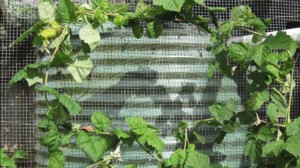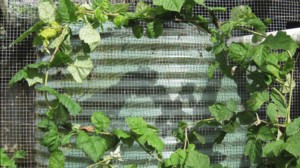By Jane Varkulevicius
A berry cage is almost essential if you want to enjoy those delicious summer fruit so beloved by birds. The cage can be seasonal or permanent and whatever berries you want to grow — raspberries, brambleberries or strawberries — can all be accommodated. Find out how to make your own.
Site:
Choose a spot facing north and east if possible — berries find it hard to cope with the hot afternoon sun. Drainage is also important: if there is only a rather waterlogged spot for your cage, build up the soil level with plenty of organic matter and your berries will love it. If you have another garden structure, such as a chookpen or garden shed, place your cage next to it if possible. Consider adding a tank to catch the shed’s water so that water is always close to your berries, as they really hate to dry out.
Ultra-simple or Taj Mahal:
A berry cage can be as simple or as fancy as your pocket allows. Painted or carved posts, exotic roof lines, finials and any other architectural detail that takes your fancy can be incorporated into your berry cage. A substantial structure might best be built in bird wire on a timber frame; it would certainly be durable, but expensive. A simpler option is to use timber poles and bird netting plus a few pieces of plank to support the net. Buy quick-set concrete for footings and netting from the local garden centre and all you need is a weekend or two to put it together. First decide how big your cage will need to be. A rectangular shape will suit most home gardeners and ensure that all the berries have access to half a day’s sun. A module of 3m to 3.6m long, 2.4m wide and 2m high will allow room for bramble berries, raspberries and a few strawberries, plus room to move when tending and picking. If you plant only raspberries or brambleberries* the cage can be narrower; about 1.5m to 1.8m wide for a single row of raspberries or brambleberries, with perhaps some strawberries underneath.
Materials:
6 125mm diameter × 3m long timber poles
3 timber slats 25mm × 50mm × 2.4m long
2 timber slats 25mm × 50mm × 3.6m long
6 bags quick-set concrete mix
40m2 bird netting to cover
Nails & staples
The average 100g punnet of summer berries is about $5 and the berry cage in its second year would produce about four kilos of berries, ready to eat off the bush and couldn’t be fresher. To buy that amount of berries, tired as they often are when transported, would cost $200.
Within three years, the cage would have more than paid for itself and you can enjoy the best flavours of summer from your own backyard.
Method:
- First, plan out the area and mark where the poles are to go and the footings are to be dug. Use a string line to ensure you get them straight. Posts can be a maximum of 1.8m apart.
- The hard part. Dig the footings for your poles 1000mm deep and 450mm wide. Place some concrete mix in the base of the hole and insert the pole. Back-fill with the rest of the concrete mix and tamp down any extra soil needed to fill the hole to ground level. See construction picture. Check with a level to ensure the post is straight.
- Reward yourself with an ice-tinkling drink while you leave the concrete to cure — perhaps until next weekend or at least 24 hours for it to harden completely.
- Nail the timber slats to the top of the posts, first lengthways and then across, Weekend gardening Weekend gardening using 75mm to 100mm nails. See the plan view drawing and detail.
- Remove any traces of the concrete or any soil that has been contaminated by it. Concrete is extremely alkaline and will harm your berries, which prefer an acid soil.
- If the site is prone to water-logging now is the time to build up the soil. Layer straw/ very wet old newspapers with manure/ blood and bone/manure pellets until a bit above the height you want to achieve. Make planting holes filled with your best compost or good quality potting mix and plant your new berries in them.
- Arrange your bird-netting over the structure. You can just drape it over or fix it permanently. You will have plenty left over to use on your other fruiting plants.
* Brambleberries loganberry, boysenberry etc will need an extra wire at 1.2m from the ground.







